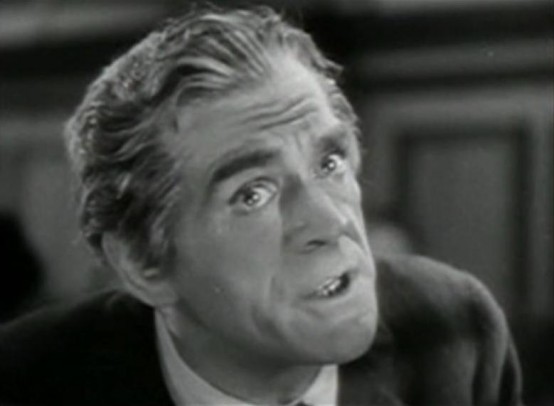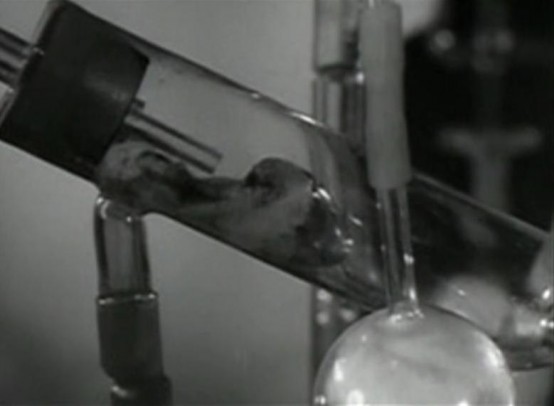Warner Brothers zaps Boris Karloff back to life with a plot device torn from the headlines so he can exact vengeance on a group of racketeers led by Ricardo Cortez and Barton MacLane. I tell you, if I was Warner Brothers and got a hold of Karloff, this is what I’d want to do with him too!
On top of those elements Michael Curtiz was assigned to direct and reunited with Captain Blood (1935) cinematographer Hal Mohr, who took home the first of his two Academy Awards right around the time The Walking Dead premiered. The result was more shadows and angles than we’re used to seeing in a 1936 Hollywood film, most notably during Karloff’s walk to the electric chair, a scene that anticipates Curtiz’ Angels with Dirty Faces (1938) in action, though not mood, and Gwenn’s unveiling of Karloff to the local notables during an unsettling piano recital.
For producer Louis F. Edelman, The Walking Dead was sandwiched between two more traditional gangster movies, each of which wound a different route towards Production Code acceptability. As you’d expect by its title, G Men made the gangsters the bad guys and brought James Cagney back to the genre on the right side of the law, even if he still acts a whole lot like Tom Powers of The Public Enemy (1931). After The Walking Dead, which certainly found its own intriguing way to incorporate organized crime, Edelman was given charge of Bullets of Ballots, this time starring Little Caesar himself, Edward G. Robinson, but for laughs. Warner contractee Barton MacLane appeared in all three movies.
In The Walking Dead, MacLane plays a member of a gang of racketeers led by hot shot defense attorney Nolan (Ricardo Cortez). Other key associates are Merritt (Robert Strange) and Blackstone (Paul Harvey), though neither of them is nearly as confident as the characters played by the two better known actors. When Judge Shaw (Joe King) foils this group at the open they conspire to have their muscle, Trigger (Joe Sawyer), rub out the judge and foist blame on recently released convict John Ellman (Karloff), himself previously convicted by Shaw. The plan nearly backfires when a young couple (Warren Hull and Marguerite Churchill) witness the set-up, but are hushed-up through Ellman’s murder trial from fear of reprisal. Churchill and (especially) Hull are almost incidental to this story, except their characters do work for one Dr. Beaumont (Edmund Gwenn) of the Medical Sciences Foundation Research Laboratories.
Don’t worry if this all sounds kind of silly, because it is, and it is about to stretch the imagination even further, but Boris Karloff stands out in the middle of this potential chaos by giving one of his finest performances. But he has to die first.
And die he does, after pages peel off a calendar marking time towards Ellman’s execution day. A fine time for the young couple to admit that they were the mystery witnesses and beg Dr. Beaumont to help save the condemned man. Beaumont does the logical thing and phones Ellman’s lawyer, Nolan, played by our smarmy friend Ricardo Cortez. Cortez, usual smirk in place, cools his cronies by delaying his call to the District Attorney (Henry O’Neill) until he finishes dinner. With the D.A. in tow Nolan arrives at Dr. Beaumont’s lab and puts on a fine display of mock outrage while the District Attorney is seconds late in delaying Ellman’s execution. Those prison guards always find the most inconsequential subjects to meander over when that switch is about to be pulled.
Back at the lab, Dr. Beaumont begs the District Attorney to call off the autopsy. He wants to play with his new toy, a Lindbergh Heart.
On August 31, 1935 the Journal of Experimental Medicine, the official publication of the Rockefeller Institute for Medical Research, published an article titled “An Apparatus for the Culture of Whole Organs,” authored by Charles A. Lindbergh. Yes, that Lindbergh. Since 1930 the famed flier had been working with Nobel Prize winning scientist Dr. Alexis Carrel towards a Pyrex glass piece of equipment that was able to keep organs alive outside of the body. This piece of equipment was called a “profusion pump” by the medical community, nicknamed “artificial heart” by a science reporter at the New York Times and more commonly called “robot heart” by the more general layman and reporter.
Journalist Leonard A. Barrett offered a concise description of the “Lindbergh Heart” in April 1936:
”The mechanism consists of glass tubes of various dimensions, glass receptacles, and so on, into which can be placed a wounded part of the body, and the healing process watched and studied with scientific precision. In other words, the parts of the human body such as a diseased thyroid gland, or kidney, can be made to function under normal conditions, because the receptacle into which these organs are placed functions exactly as does the human body.”
He should have just sent his readers to the theater.

Just to be clear, the Lindbergh Heart kept organs alive outside the body–it never resurrected the dead, not even Karloff!
Producer Lou Edelman sounded a lot like former Warner Brothers production chief Darryl F. Zanuck when he said, “Anything worth newspaper space is worth a picture” (Casty 35). The Lindbergh Heart certainly fell within those specifications. According to Hollywood journalist Henry Sutherland, Warner Brothers obtained special permission to duplicate the Lindbergh Heart and assigned Dr. Stanley Fox of Western Scientific Research Laboratories the task of constructing the second such apparatus in existence for The Walking Dead. So says Warner Brothers through Mr. Sutherland, I suppose.
The Walking Dead premiered in New York, March 1, 1936, for an audience who would immediately understand just what Warren Hull meant when he told Marguerite Churchill, “Keep that Lindbergh heart pulsating, Nancy. See that it doesn’t stop.” For a modern audience, unfamiliar with the term or the imagery, the Lindbergh Heart gets lost amongst a lab filled by all the usual tubes and beakers, accented by bolts of light over the familiar figure of Karloff strapped to a table see-sawing back and forth amid static sounds and tense faces.The Film Daily reported that for The Walking Dead’s premiere at the New York Strand the lobby display was comprised of several still photos of the Lindbergh Heart scene from the movie, accompanied by real newspaper clippings triumphing the actual invention. They had even more fun at the Spreckels Theater in San Diego where the “robot heart” name was played for full effect by the presence of “a huge mechanical robot, eerily lighted” that was set up in the main lobby. Outside a man in a robot suit that advertised the theater “stalked the streets with uncanny effect.” They pulled out some old tricks in San Diego too, hiring a girl to faint in the crowd and using the resulting photograph in an ad promoting the film. They also dressed up someone in a medical uniform and kept first aid supplies nearby in the lobby during that premiere.
“He’s alive,” says soft-spoken Gwenn, adding, “He will live.”
John Ellman reborn is Karloff with a shock of white streaking through his hair moving about in a slow gait accentuated by his hunching to one side. Karloff’s Ellman looks sad and distant upon his rebirth. He’s no monster. He sits quiet and still until revitalized by music, a life-long passion that still possesses even this resurrected version of Ellman. Hearing Nancy (Churchill) play the piano he rises, a look of reverence sweeping over his features, as he skulks towards the piano. He sits and plays.
Suspicion is aroused when this blank, empty man rises to anger when his attorney, Nolan, visits. Nolan immediately concludes, “The man’s insane.”
After kibitzing with the District Attorney, Dr. Beaumont decides to reintroduce John Ellman to the world not “as the man that returned from the dead,” but “as a pianist.”
This is the best scene of The Walking Dead as the expressionless Karloff sits before a crowd including all of those who had conspired against him. His dark eyes pierce the room while his face is lighted in tighter and tighter close-ups that accentuate Ellman’s distance in spirit, no matter how near he may appear. His calm menace is contrasted by the terror that creeps over Blackstone and Merritt, who soon run from the room.
Ellman, who remembered nothing upon his return, has been sparked by something within to stalk his enemies to their graves. Rather than commit murder he simply inspires death. While this begins impressively The Walking Dead sputters some as the body count mounts and the death scenes begin to feel improperly weighted. Too much time in one place, not enough in another.
While the movie sends each of those walking dead to their end in original fashion, the highlight of every kill turns out to be Karloff’s slow stalking of his prey. He asks more than once, “Why did you have me killed?” with menace giving way to regret, perhaps empathy, and certainly horror as his enemies perish before him, not at his hand, but by his will.
Karloff is outstanding. I didn’t make much mention of it, but he’s every bit as good as Ellman early in the movie before the executioner’s switch is thrown. There is no menace to that Karloff, an unemployed ex-con who cheerfully seals his own demise by taking up an offer of a free cup of coffee.
The other cast members give what is expected of them with Cortez in rakish gangster mode and MacLane as one of his typical barking villains. Warren Hull disappears and Marguerite Churchill, who next appeared in a more traditional horror film for Universal, Dracula’s Daughter (1936), doesn’t do much to stand out.
Edmund Gwenn, recently transplanted from England to Hollywood and coming off of a bigger movie at RKO, Sylvia Scarlett (1935), makes for a sober scientist, especially compared to what we’re used to. This is no mad scientist, but Gwenn’s Dr. Beaumont does have a growing obsession with “secrets from the beyond” and needs to know what Karloff’s Ellman experienced in that time between his electrocution and resurrection. It’s not surprising that a Hollywood “B” movie cannot answer that question for us and Gwenn is reassuringly sane when the movie ends without providing the ultimate answer.
The Walking Dead is run-of-the-mill gangster stuff with a horror twist but an exemplary performance by Boris Karloff, who always gave heart and soul to his work, that boosts its status in both genres. It’s a must for Karloff fans and will be enjoyed by those who love both the Universal monsters and Warner Brothers gangsters.
The Walking Dead is available on DVD from Warner Home Video as the best of four films in their otherwise underwhelming Karloff & Lugosi Horror Classics set from 2009. The Warner Brothers release also airs periodically on Turner Classic Movies, which is where the screen captures on this page originated.
Sources
- Barrett, Leonard A. “The Lindbergh Heart.” Indiana Weekly Messenger 23 Apr 1936: 16. Web. Newspaper Archive. 26 Oct 2013.
- Casty, Alan. Robert Rossen: The Films and Politics of a Blacklisted Idealist. Jefferson, NC: McFarland, 2013.
- Ehrlich, Joseph C., M.D. Letter. New York Times 21 Feb 1985. Web. New York Times Archive 26 Oct 2013.
- ”Spreckles Stages Unusual Stunts for ‘Walking Dead.’” Film Daily 20 Apr 1936. Web. Media History Digital Library. 24 Oct 2013.
- Sutherland, Henry. “Hollywood Sidelights.” Sandusky Star Journal 14 Dec 1935: 2. Web. Newspaper Archive. 26 Oct 2013.

[phpbaysidebar title=”Boris Karloff on eBay” keywords=”Boris Karloff” category=”45100″ num=”5″ siteid=”1″ sort=”EndTimeSoonest” minprice=”29″ maxprice=”99″ id=”2″]











Leave a Reply